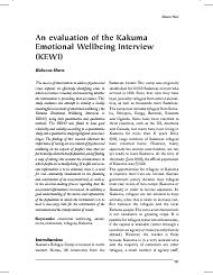An evaluation of the Kakuma Emotional Wellbeing Interview (KEWI)
The success of interventions to address psychosocial issues depends on effectively identifying areas in which assistance is needed, and measuring whether the intervention is providing that assistance. This study evaluates one attempt to develop a locally meaningful assessment of emotional wellbeing (the Kakuma Emotional Wellbeing Interview or KEWI) using both quantitative and qualitative methods. The KEWI was found to have good reliability and validity according to a quantitative study, but a qualitative study highlighted some challenges. The findings of this research illustrate the importance of basing an assessment of psychosocial wellbeing on the aspects of people’s lives that are particularly salientto that population, and of finding a way of taking into account the circumstances in which people are actually living If useful and accurate information is to be obtained, there is a need for real community involvement in the planning and construction of an assessment tool, as well as in the decision-making process regarding how the assessment information is to be used. In addition, a good understanding of the norms and expectations of the population in which the instrument is to be used is necessary, both for the construction of the instrument and the interpretation of results.
Geachte bezoeker,
De informatie die u nu opvraagt, kan door psychotraumanet niet aan u worden getoond. Dit kan verschillende redenen hebben,
waarvan (bescherming van het) auteursrecht de meeste voorkomende is. Wanneer het mogelijk is om u door te verwijzen naar de bron
van deze informatie, dan ziet u hier onder een link naar die plek.
Als er geen link staat, kunt u contact opnemen met de bibliotheek,
die u verder op weg kan helpen.
Met vriendelijke groet,
Het psychotraumanet-team.
Reference:
Rebecca Horn | 2009
In: Intervention: the international journal of mental health, psychosocial work and counselling in areas of armed conflict, ISSN 1571-8883 | 7 | 3 | 223-238
http://www.interventionjournal.com/sites/default/files/7.3.%20Horn.pdf
In: Intervention: the international journal of mental health, psychosocial work and counselling in areas of armed conflict, ISSN 1571-8883 | 7 | 3 | 223-238
http://www.interventionjournal.com/sites/default/files/7.3.%20Horn.pdf


